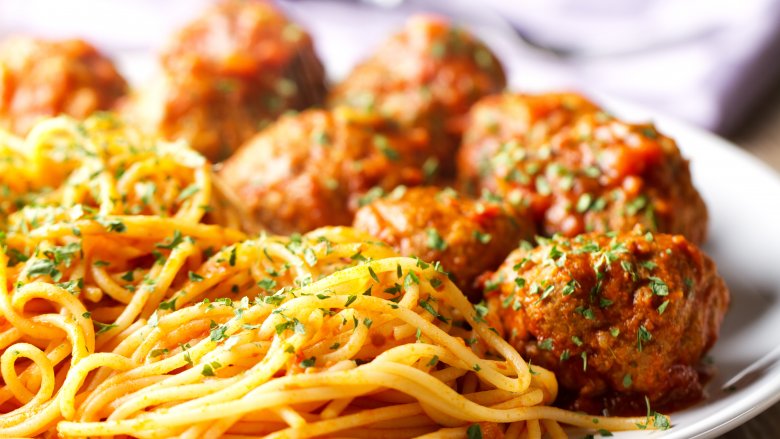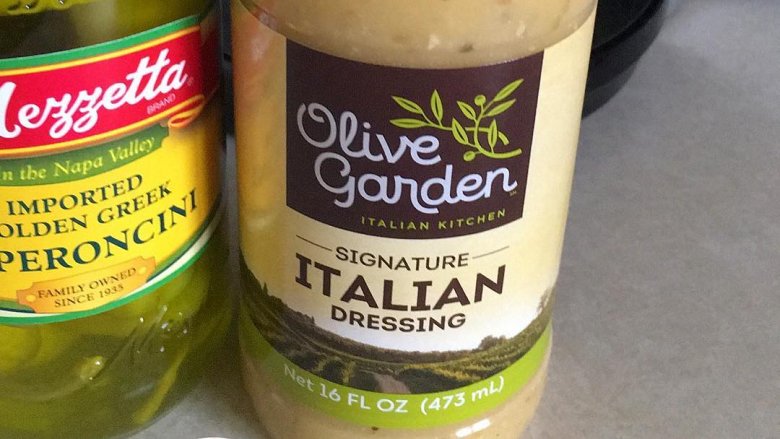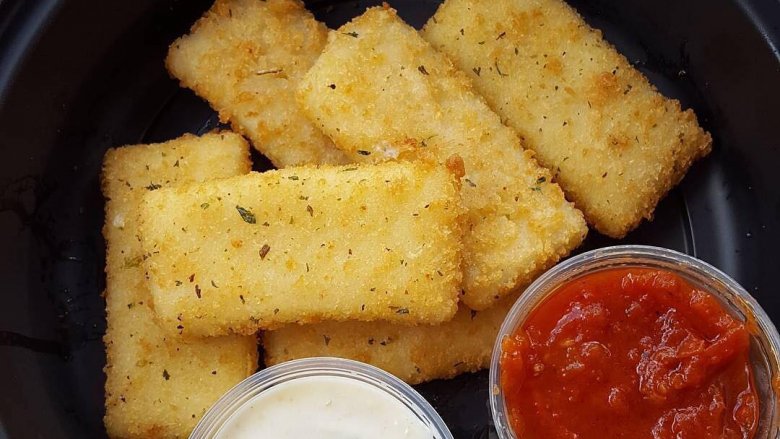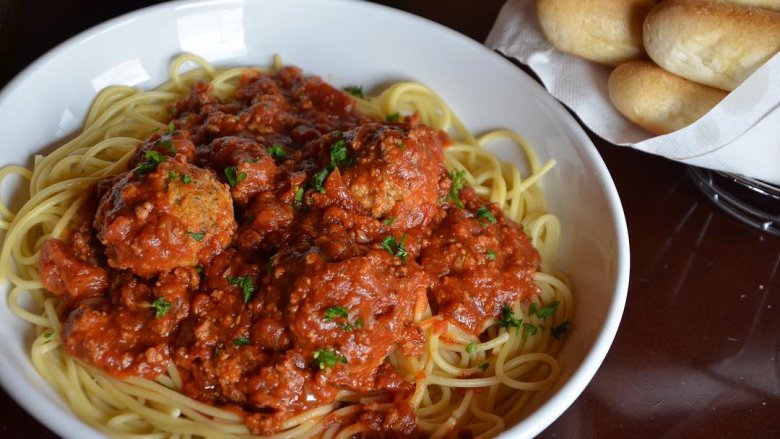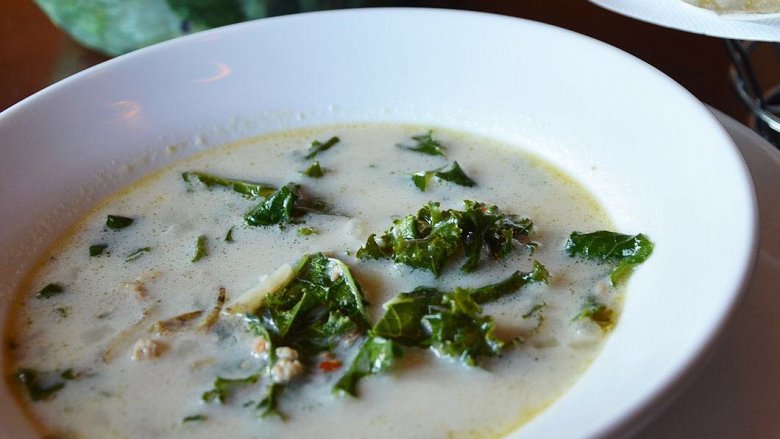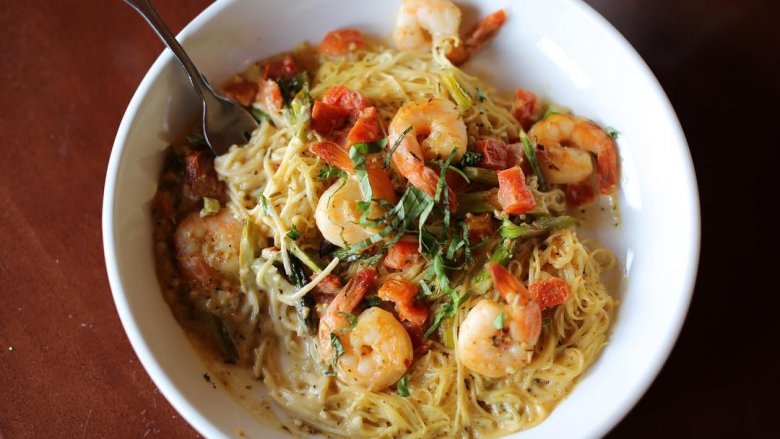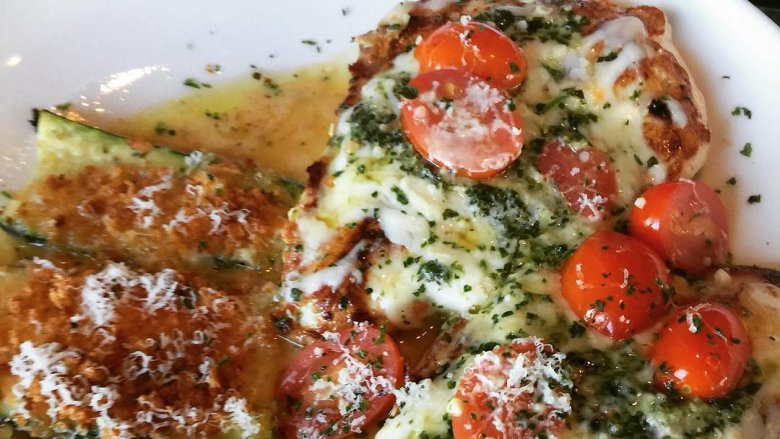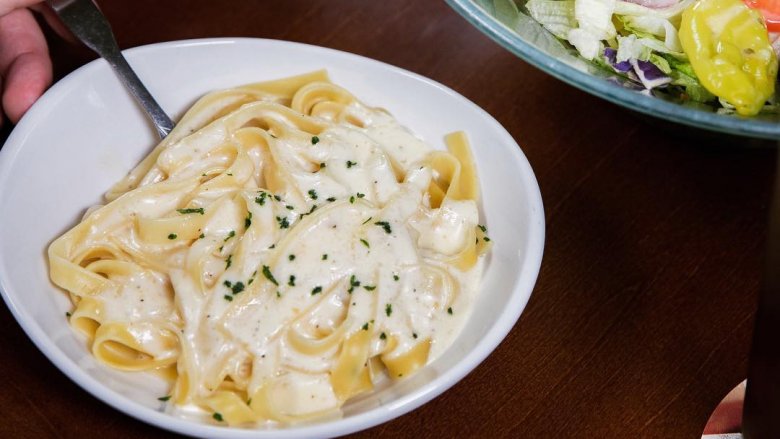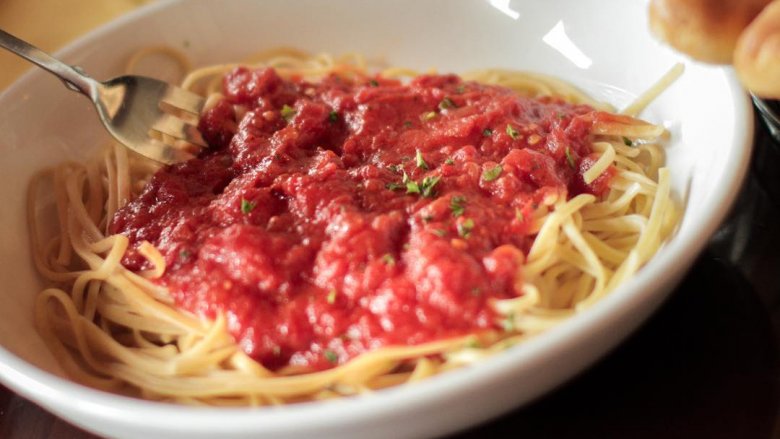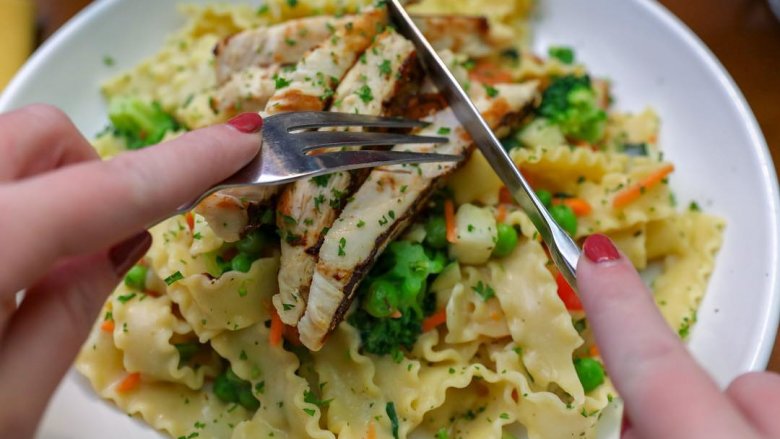Olive Garden Dishes That Are Totally Not Italian
Olive Garden isn't just a restaurant — it's a pan-national, multi-billion dollar franchise that, since its inception in 1982, has become something of a landmark in America's casual dining scene. To many, Olive Garden might be seen as the most readily available and affordable Italian food around. And when you walk through those doors and take in the Tuscan-style decor, you might assume you're about to sit down to a meal comparable to what you'd be served in Italy. There's nothing like an authentic Italian experience without the need for a passport (or the cost of a plane ticket), right?
However, Olive Garden actually styles itself as an American-Italian restaurant — not an authentic Italian eatery (they just don't go out of their way to advertise that fact). What this means is that even though you may think you're getting an authentic Italian meal, you're probably not. Especially if you order these dishes...
Italian dressing
Let's start the same way they do — with the salad. That complimentary, bottomless bowl of salad comes topped with their own signature Italian dressing. But Italian dressing — whether you've found it at Olive Garden, in a supermarket or at any other restaurant — simply does not exist in Italy. Olive Garden's variety contains oils, vinegars, corn syrup, salt, egg, cheese, garlic, sugar, spices and a whole load of chemicals to boot. Italians, however, apply only three things to their salads: salt and pepper, oil and vinegar.
The oil tends to be olive oil, while white wine, red wine and balsamic vinegars are also applied. Those are what you'll find on the table in an Italian home or restauarant, and you'll be expected to apply it yourself. The very notion of a "dressing" filled with additives, syrups and sugars being dolloped onto a good salad is nothing short of sacrilege.
Mozzarella sticks
We're not doing down mozzarella sticks, here, trust us. Hell, they're a great idea: crispy on the outside, just gooey enough on the inside and preferably served hot enough to permanently scar you. Nothing at all against them — they're just not Italian, even though they're on the menu at Olive Garden.
The first recipe for breaded cheese sticks can be found in Le Menagier de Paris, a medieval cookbook dated 1393. As the name suggests, it originates in France. The origin of mozzarella itself is up for debate, but the idea to cook it into sticks is strictly French — while their growing popularity over recent years is almost entirely a quirk of American dining. They're still great, though. No denying that.
Spaghetti and meatballs
This one might come as a bit of a surprise. After all, isn't spaghetti and meatballs pretty much synonymous with Italian dining, if not Italy in general? Ask any half-decent TV show or cartoon (and any of the bad ones, too) and you're likely to end up assuming that it's literally all they eat. Well, spoiler alert: it's not.
Let's start with meatballs. They're thought to have come from a number of places, including Sweden, Turkey and, yes, Italy. But Italian meatballs are nothing like what you'll find in at the Olive Garden — they're far smaller and are often eaten by themselves. The recipe for spaghetti and meatballs as Americans know it was created by Italian-American immigrants who cooked up the idea because the ingredients were affordable and easy to find.
Zuppa toscana
Zuppa toscana, which means "soup in the style of Tuscany", is, well, a soup that originates in Tuscany. In that sense, it is actually an Italian dish. But the American version of the recipe, as it's served at Olive Garden, couldn't be further from its Italian counterpart. Soup in Tuscany is made from kale, beans, zucchini, potatoes, celery, carrots, onion, tomatoes and seasonings, served with toasted bread and rigatino bacon.
Olive Garden's version is more of a broth, made from sausage, red peppers, onion, bacon, cream, potatoes and kale and, unsurprisingly, is somewhat less healthy than what you'll find in Italy. If you are lucky enough to find yourself among the rolling hills of Tuscany, don't expect this soup to be anything like Olive Garden's. Then count yourself twice lucky.
Shrimp scampi
Seafood is a quintessential part of Italian cuisine, especially around the coastal reaches. In some regions, such as the Amalfi Coast or down in Puglia, it's pretty much all they eat, and if you ever find yourself down there you're likely to get a taste for some of the finest seafood you've ever tried.
The key thing to understand here is that "shrimp scampi," as a phrase, makes basically no sense. Scampi are small lobsters found in the Atlantic and Mediterranean that are a staple part of the Italian seafood diet. Shrimp are related, but altogether different animals. The story goes that Italian-American immigrants replaced the scampi in this recipe with shrimp because the latter was more readily available in the United States. So don't go asking for "shrimp scampi" in Italy, because all you're likely to get is a strange look and a shrug.
Chicken Parmigiana
For the uninitiated, chicken Parmigiana is a dish of breaded chicken breast topped by a tomato sauce, mozzarella and melted cheeses. It's a fairly popular dish in the United States, and at Olive Garden, but — well, you can probably guess what's coming.
The ingredients may be Italian, but the dish sure ain't. Now, Parmigiana itself is actually a well-known recipe in Italy, but it's the chicken part that constitutes an American invention. In Italy, the dish is far more frequently made with eggplant. It's breaded, fried and topped with sauce and cheeses, then baked. Once again, the reason for this change comes from the experience of Italian-American immigrants, who found chicken more popular and readily-available in the States.
Fettuccine Alfredo
No. No, no, no, no, no. Absolutely not. Fettuccine Alfredo is, essentially, pasta with butter and cheese — that is, with no real sauce to speak of — and the very notion of eating pasta without sauce is likely to get you institutionalized in Italy. Pasta in bianco, as the locals call it, is often used as a light comfort food, served to children with upset stomachs or pregnant women who are experiencing nausea.
The simple fact is that Alfredo sauce as an actual menu item is a strictly American invention which grew in popularity thanks to a series of New York restaurant chains. It is not an Italian dish, and the only places you'll find in Italy with it on the menu are establishments which are catering specifically to tourists. Or, yeah, pregnant women. Stick to the sauce.
Spaghetti with meat sauce
Finding out that one of the most popular Italian dishes on the planet isn't actually Italian is the sort of bombshell revelation that could drive someone into the very depths of madness. Well, rev up that lobotomizer, because we've got news for you: Spag bol — or, as Olive Garden attractively calls it, spaghetti with meat sauce — doesn't really exist in Italy.
The truth is that, outside of the tourist traps, Bolognese sauce is usually only served with tagliatelle, tortellini or gnocchi in Italy, and certainly never with spaghetti. The idea is that those pastas, which are far thicker and heavier than spaghetti, are better suited for holding the sauce, which is thick and chunky. There's no doubt that you'll find spaghetti in Italy, and there are plenty of different variations on Bolognese, which come from a number of places all around the country, but the simple fact is that the two just aren't put together.
Any combination of chicken and pasta
Olive Garden seem to have a bit of a thing for combining chicken and pasta. You've got the chicken giardino (pappardelle with chicken), the chicken Parmigiana (which is served with spaghetti), chicken carbonara (alright, whatever) and the chicken Alfredo. Say it with us, Olive Garden: Italians do not eat chicken with pasta.
Seriously, take a look around. Fly to Italy, maybe. Try out some small restaurants, or go for dinner at someone's house. You simply will not come across any of those dishes, nor anything remotely like them. There's really not much more to it than that — the two ingredients just don't go together. You might, might, find chicken pasta at tourist spots in Italy's larger cities, but, beyond that, this Frankenstein-esque combination is more likely to bring your waiter to tears than it is to bring you anything resembling a truly memorable Mediterranean meal.
Soffatelli
Some Olive Garden dishes come from Italian-American recipes, some come from a bit further afield, and some, it seems, are completely made up. Dishes which fall into the latter category include "soffatelli," a sort of puff pastry filled with cheeses, herbs and meat, served in a garlic sauce. While it may sound pretty delicious, the weird truth of it is that even Italian chefs (or all chefs for that matter) actually had no idea what it was.
Pastachetti
While soffatelli can be commended for at least having a name which sounds vaguely Italian, the same cannot be said for its ill-fated sibling: "pastachetti." These ribbons of pasta, stuffed with cheese and chicken or sausage, have a name which sounds as Italian as the recipe, and a recipe that's about as Italian as a man in lederhosen eating haggis on the banks of the Seine.
Eventually, they came clean about it. Olive Garden admitted in 2011 that they had actually fabricated these dishes themselves, which they claimed were simply "rooted in the Italian inspiration our chefs draw from when developing these dishes," whatever that means.
